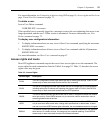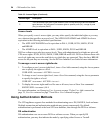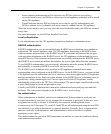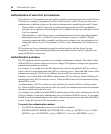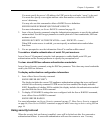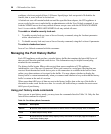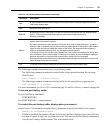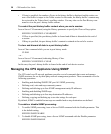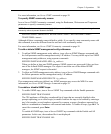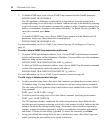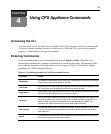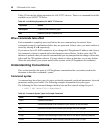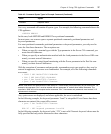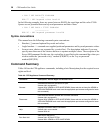
Chapter 3: Operations 31
For more information, see Server SNMP command on page 58.
To specify SNMP community names:
Issue a Server SNMP Community command, using the Readcomm, Writecomm and Trapcomm
parameters to specify community names.
NOTE: The default community names are “public”; if you enable SNMP, you are encouraged to change the
community values to prevent access to the MIB.
SERVER SNMP COMMUNITY READCOMM=<name> WRITECOMM=<name>
TRAPCOMM=<name>
Although all three community names default to public, if you specify a trap community name with
this command, it must be different from the read and write community names.
For more information, see Server SNMP Community command on page 58.
To add or delete SNMP management entity addresses:
1. To add an SNMP management entity address, issue a Server SNMP Manager command with
the Add parameter and the management entity’s IP address. You may define up to four SNMP
management entity addresses, using separate commands.
SERVER SNMP MANAGER ADD <ip_address>
When you define at least one SNMP manager, SNMP requests are processed if they are from
one of the defined SNMP managers. If a request is not from one of the defined SNMP
managers, the SNMP request is discarded.
2. To delete an SNMP management entity address, issue a Server SNMP Manager command with
the Delete parameter and the management entity’s IP address.
SERVER SNMP MANAGER DELETE <ip_address>
If no management entities are defined, any SNMP manager may access the MIB. For more
information, see Server SNMP Manager command on page 59.
To enable or disable SNMP traps:
1. To enable SNMP traps, issue a Server SNMP Trap command with the Enable parameter.
SERVER SNMP TRAP ENABLE
The CPS appliance will display a numbered list of traps that are currently disabled with a
prompt requesting you to select trap(s) to enable. Indicate the traps to be enabled by entering a
trap’s list number, several numbers separated by commas, a range of numbers separated by a
dash or a combination of numbers with commas and dashes. To enable all traps, type
ALL. To
cancel the command, press
Enter.
- or -
To enable all SNMP traps, issue a Server SNMP Trap command with the Enable and All
parameters. In this case, the numbered list is not displayed.
SERVER SNMP TRAP ENABLE ALL



